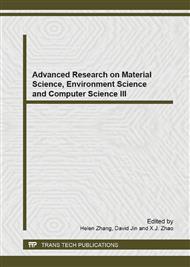p.59
p.63
p.66
p.71
p.75
p.80
p.84
p.88
p.92
Experimental Fabrication and Property Research of Thermo-Sensitive Organic-Inorganic Hybrid Nano-Microcapsule
Abstract:
A thermo-sensitive organic-inorganic hybrid nanomicrocapsule was synthesized by miniemulsion polymerization through introducing N-isopropyl acrylamide (NIPAM) monomer to the copolymer of styrene that coat around the octane droplet and 3-trimethoxysil propyl methacrylate (MPS). The penetration and releasing behavior of cresol red in this nanomicrocapsule nearby the critical temperature was investigated with ultravioletvisible spectroscopy. The results showed that both the introduction of NIPAM monomer and the temperature affect the loading and releasing of cresol red in nanomicrocapsule and the microcapsule exhibited a certain penetration rate above the critical temperature, but the penetration was inconspicuous below the critical temperature, denoting that this nanomicrocapsule could realize on-off type of environmental thermo-sensitive controlled absorption and release.
Info:
Periodical:
Pages:
75-79
Citation:
Online since:
January 2014
Authors:
Price:
Сopyright:
© 2014 Trans Tech Publications Ltd. All Rights Reserved
Share:
Citation:


